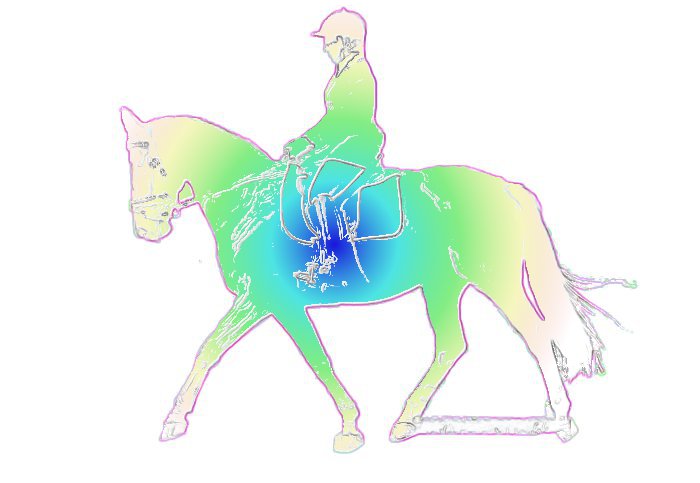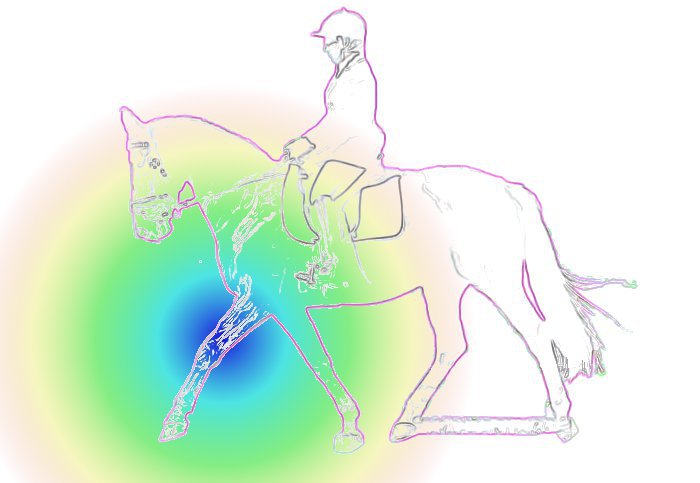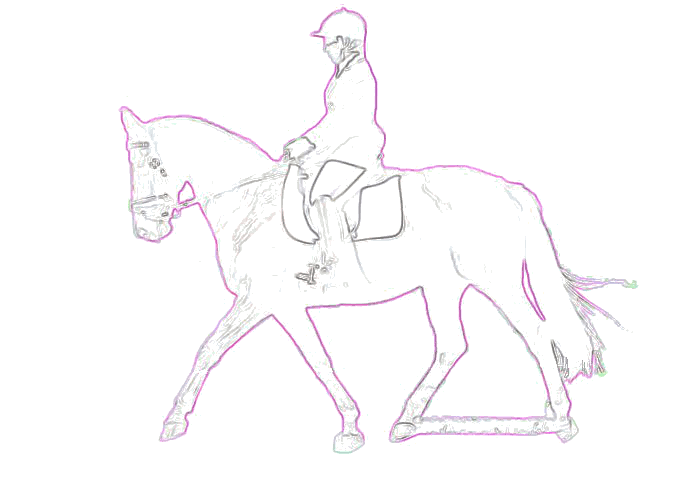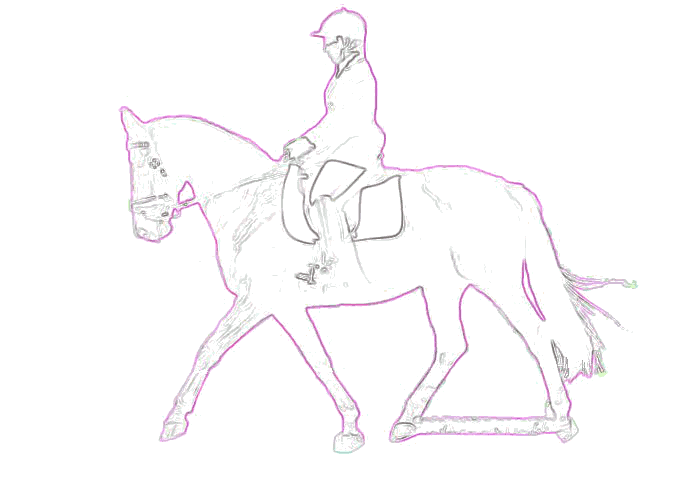Moving the Balance Point
Towards Self
Carriage
One of my horses could dig trenches. I'm quite
sure of it. I've seen other horses with similar build
and they kind of want to dig trenches, too. But
that's really not why I ride horses. And not
only is it not so spiffy for us on their back, it's
really not so spiffy for them in the long run.
One of the ways I support horses to rebalance is through
conceptualizing where their balance point is in their body
and then getting them to change is by modifying what I'm
thinking. I tend to visualize this, which is handy for
communication here, this being a visual medium; however, it can also be communicated
to the horse through a sense of density or the sense of hearing.
Which is most effective with your horse will depend upon
you and your horse.
Finding the Starting Point
In a well balanced horse, the 'ideal'*
balance point is
somewhere close to half way up the ribcage underneath where
the withers transition into the back. I like to see
the balance point as a starburst emanating from where ever
it is I think the center is, like this:

If you or your horse is audio,
you could imagine this is where a speaker is located.
When the horse is balanced, the tone from the speaker is
pleasant. If you or your horse are kinesthetic,
this will be a density. If you ever played with goop or
mixed batter, it would be the lumpy part.
In the trench-digging horses, this point is
a lot further forward and down. Maybe something like
this:

To find this point, what you, the rider, do is a kind of
'pin-the-tail-on-the-donkey' approach. Or, as I learned
in my son's math class, a 'Guess and Check.' You
guess about where the balance point might be and then you add
in your visualization, speaker, or glob of goo to represent it
accordingly. If you get it right, you and your horse
will immediately feel better. Although you may still be
digging trenches, it will actually feel better. If
you don't feel better, guess where else it might be, add in
your conceptualization of it, and then check for feedback in
your won body. Keep doing this until you find a place
that's better.
Amplification Approach
The Amplification Approach, based on Ortho-Bionomy, is
to make things just a little bit more so. This gets the
nervous system to pay attention and
self-correct.
With this approach, you move the balance point a little
bit further down and forward. In this instance,
it's like there's a rubber band between where the horse's
balance actually is and where you'd like it to be and you
mentally pull on the rubber band moving the balance point down
and forward. Mentally hold it there until you feel
the rubber band pull the balance point further towards the
ideal. This will take maybe a minute or two for the
release to begin. When the release occurs, and movement
starts traveling back to the 'ideal,' the result may travel
all the way or part way, and it may go quickly or
slowly.

The degree of 'better' that you get after is dependent
upon how well you amplified the pattern and will also be
dependent to the structural capabilities of your horse.
A horse that's been moving out of balance may have built up physical
compensations -- asymmetries in muscle and hoof, for
instance. And will probably also have a little bit of a
mental habit to move unbalanced.
Exploration Approach
The Exploration approach, based on Feldenkrais
Technique, provides the system with alternatives which, given
an environment of safety, allows the system to hone in on the
best fit solution.
With this approach, you find a single variable to
tweak. In the case of the horse with a low, forward
center of gravity, you can pick a slide between where the
horse is at and where you want the horse to be. I
like to hold for a count of '4' and move for a count of
'4.' This count is based upon the gait of the horse with
each count timed for the footfall of the same foot.

I slide through the options, kind of 'putting them on
the table for consideration,' maybe three or four times and
then I leave it alone. The horse may then readjust to
any of the points along the continuum, the ideal, or even
where it started. Even though we have a desire for the
horse to rebalance to the 'ideal' it's important to let the
horse find its own balance point.
Ultimately, the horse's system decides. If I hold
something in place and make it happen, then the system does
not learn and does not adopt a new way of moving. When
something is held in place when it's not ready there is an
inherent resistance. Sometimes the trade off is the
lesser evil; however, in this approach, horses aren't held
where they can't hold themselves.
Usually with this approach, the two endpoints are
equidistant on either side of the ideal. In this case,
the other point would be somewhere over the horse's
croup! Perhaps a bit too extreme. It may be
possible to pick a point behind the cantle, or between the
rider's heel and the horse's hip and play with it to see how
much closer to the 'ideal' the horse can get.
Double Exposure Approach
The Double Exposure Approach, based on Alexander
Technique, is a feedback loop letting the horse know where
it's at and where the 'ideal' is. By using this
double exposure, there is a beacon type quality -- and a
question posed to the horse's system. "You are
here; this is where the 'ideal' place is; how are you going to
get here?" You then allow the horse's system
to do something. Which, that could be a really seemingly
off thing from a subjective point of view, which you have to
respond to objectively with the same question: "You
are here; this is where the 'ideal' place is; how are you
going to get here?" You can repeat this question
several times if you make sure it always stays neutral in
expectation. It is simply feedback. (at the
moment, I'm having fits w/ gimp! (!!!!) when I figure
this out, I'll add more to the gif.)

If you are patient, this approach can be very fruitful,
allowing the horse to pick a very optimal solution to the new
information. The trick is to be incredibly objective,
neutral, and impartial. This is the horse's process and
any 'solution' they put on the table is allowed.
(This might also require some really balanced riding on your
part.)
Give it a go!
Check it out with your horse or other horses and let me know how it goes!
The next few write ups I'll add in info about what you can
do in your own body. And if
you'd like some hands on, call me up for a
lesson. I have a good eye and can give you ideas
about what is going on with your own horse and how to solicit
the self-correction mechanisms in both of you.
Cheers!
L
* The quotes around 'ideal' indicate that this
is a concept and no-where's near absolute. The more you
work with bodies, the more apparent it becomes that where they
actually are is the best place they can be in that
moment. By giving the system new information, the best
place may (or may not!) change. This picture is of a
well-balanced lower level horse. Higher level horses can
shift their balance points further back.
|




![Centered Riding Today: An Informal Talk by Sally Swift [VHS]](http://ecx.images-amazon.com/images/I/41Vn6PfhzML._SL125_.jpg)
![Centered Riding with Sally Swift [VHS]](http://ecx.images-amazon.com/images/I/51OSh9kd9iL._SL125_.jpg)








